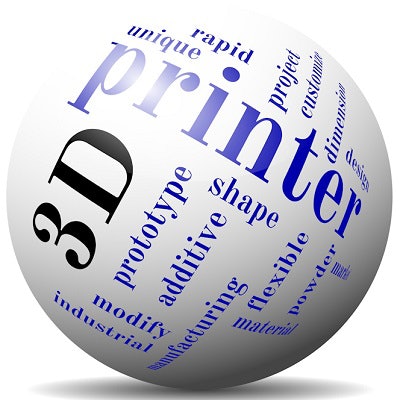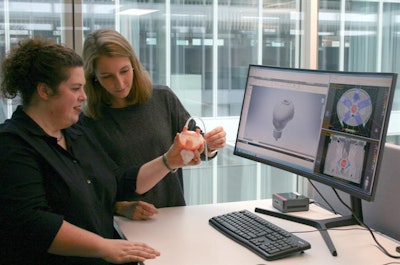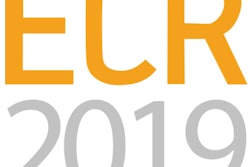
Polymer gel dosimeters can measure complex 3D dose distributions for use in patient-specific radiotherapy quality assurance. The gels polymerize upon irradiation as a function of absorbed dose -- an effect that can then be measured using MRI.
Polymer gels offer high spatial resolution, enabling measurements in steep dose gradients. However, they react strongly with oxygen and other contaminants, requiring the use of special containers of glass or Barex, which limits the size and shape of the resulting phantoms. Now, a team from the German Cancer Research Center (DKFZ) has investigated the use of 3D printing materials and techniques to create polymer gel phantoms with arbitrary geometries.
 First author Alina Elter (right) and Wibke Johnen, the medical technician responsible for the design of 3D-printed objects, discuss a new 3D-printed prostate attached to a silicone bladder for use in an anthropomorphic pelvis phantom. Photo courtesy of Alina Elter.
First author Alina Elter (right) and Wibke Johnen, the medical technician responsible for the design of 3D-printed objects, discuss a new 3D-printed prostate attached to a silicone bladder for use in an anthropomorphic pelvis phantom. Photo courtesy of Alina Elter."Printing complex shaped gel dosimeters allows us to construct phantoms that have the same shape as organs of real patients," explained first author Alina Elter. "Tumor-shaped structures and organs-at-risk located in close proximity to the tumor are of high interest. With these so-called anthropomorphic phantoms, we are now able to verify complex dose distributions in 3D under patient-like conditions."
Take your pick
Elter and colleagues compared six potential 3D printing materials. For the polymer gel, they chose PAGAT (polyacrylamide, gelatin, and tetrakis hydroxymethyl phosphonium chloride), which can be produced in-house at low cost, shows small dose rate dependence, and is evaluated with MRI, making it especially interesting for new hybrid MR-linac devices.
"We picked the five printing materials most commonly used and easiest to handle with the 3D printers available at our institute, and selected materials for a variety of different printing techniques," Elter said. "To further extend the range of printing techniques, one additional set of test vials was printed externally."
The researchers used each material to create a test vial with the same size and shape as Barex vials (which are already verified for PAGAT dosimetry). They irradiated the gel-filled test vials with a clinical 6 MV linac, using opposing 10 x 10-cm beams to create a homogeneous dose distribution over the entire volume. As a reference, they irradiated a gel-filled Barex container under identical conditions (Physics in Medicine & Biology, February 2019, Vol. 64:4, 10.1088/1361-6560/aafef0).
As the gel polymerizes, this alters the relaxation rate, R2, of the transversal magnetization, enabling evaluation of the absorbed dose via MR imaging. Approximately two days after irradiation, the researchers imaged the containers using MRI with a high resolution of 1 mm3.
The relative R2 profiles of the irradiated vials revealed that one vial material -- VeroClear, printed using an Objet30 Pro PolyJet 3D printer -- exhibited a homogenous R2 profile with a mean deviation of -1.2% relative to the Barex reference (for a representative transversal slice). Over the entire evaluated volume (15 slices; 4,072 voxels), they observed a mean deviation of -1.4%.
For three other materials examined -- PLA (polylactic acid), PVB (resin based on polyvinyl butyral), and VisiJet photopolymer -- the R2 signal decreased near to the vial walls. This is likely due to the oxygen permeability of the materials, which leads to a partial inactivation of the polymer gel. For two other materials printed using stereolithography, the team found tiny holes in the container wall.
Focusing on VeroClear
Based on their findings, the team evaluated VeroClear further. The PolyJet technique used requires a support material to create structures with overhanging shapes. After printing, this support has to be removed. The team examined three approaches: removal with a water jet; applying a 2% sodium hydroxide lye; and using support material only on the outside of the vials to avoid contact with the polymer gel. In the latter case, the vials were printed in two parts and put together using the printing material itself as glue.
Comparing R2 profiles for irradiated VeroClear vials revealed that only the approach with no support material on the inside created vials that agreed well with the Barex reference. The other methods exhibited a lower signal that decreased toward the vial walls -- likely due to chemical reaction of the gel with residual support material or the lye.
Next, the researchers used VeroClear, printed without support material on the inside, to create irregularly shaped containers. Homogeneous irradiation of the gel-filled containers generated a homogenous signal response with a similar profile to the Barex vial. The absolute signal was about 3% smaller in the VeroClear container than the reference vial.
Finally, the researchers investigated small-field dosimetry using a regularly shaped VeroClear vial. They irradiated the gel-filled vial with three 1 x 1-cm beams, with high dose gradients located within the polymer gel. The R2 profiles of this small-field irradiation were comparable for the Barex and VeroClear vials. Steep gradients were measured with high accuracy, with a deviation between the positions of the maximum signal of less than 1 mm.
"As we demonstrated that the 3D printing material shows results comparable to our gold standard, we are now focusing on more complex-shaped gel containers," Elter said. "One project deals with validation of a new prostate cancer treatment method where, prior to each fraction, the calculated plan is adapted to the new anatomy of the patient. Although the idea of performing this adaptive treatment is quite old, its realization was lacking the possibility of acquiring daily images with high soft-tissue image contrast."
Elter noted that the University Clinic Heidelberg recently installed a clinical MR-linac system. "As this system is quite new, validation of real patient treatments with anthropomorphic phantoms and 3D dosimetry is an excellent way to validate new treatment procedures and to gain confidence in applying these new adaptive procedures in patients," she said.
Tami Freeman is the medical and biophysics editor for Physics World.
© IOP Publishing Limited. Republished with permission from Physics World, a website that helps scientists working in academic and industrial research stay up to date with the latest breakthroughs in physics and interdisciplinary science.



















